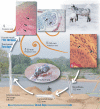Of mice, cattle, and humans: the immunology and treatment of river blindness
- PMID: 18446236
- PMCID: PMC2323618
- DOI: 10.1371/journal.pntd.0000217
Of mice, cattle, and humans: the immunology and treatment of river blindness
Abstract
River blindness is a seriously debilitating disease caused by the filarial parasite Onchocerca volvulus, which infects millions in Africa as well as in South and Central America. Research has been hampered by a lack of good animal models, as the parasite can only develop fully in humans and some primates. This review highlights the development of two animal model systems that have allowed significant advances in recent years and hold promise for the future. Experimental findings with Litomosoides sigmodontis in mice and Onchocerca ochengi in cattle are placed in the context of how these models can advance our ability to control the human disease.
Conflict of interest statement
The authors have declared that no competing interests exist.
Figures




References
-
- Thylefors B, Alleman M. Towards the elimination of onchocerciasis. Ann Trop Med Parasitol. 2006;100:733–746. - PubMed
-
- African Programme for Onchocerciasis Control. African Programme for Onchocerciasis Control Web site. 2008. Available: http://www.apoc.bf/en/index.htm. Accessed 8 April 2008.
-
- The Carter Center. IACO 2004 held in Atlanta. Eye of the Eagle volume 6, number 1. Jan, 2005. Available: http://www.cartercenter.org/documents/1969.pdf. Accessed 27 March 2008.
Publication types
MeSH terms
Substances
Grants and funding
LinkOut - more resources
Full Text Sources

